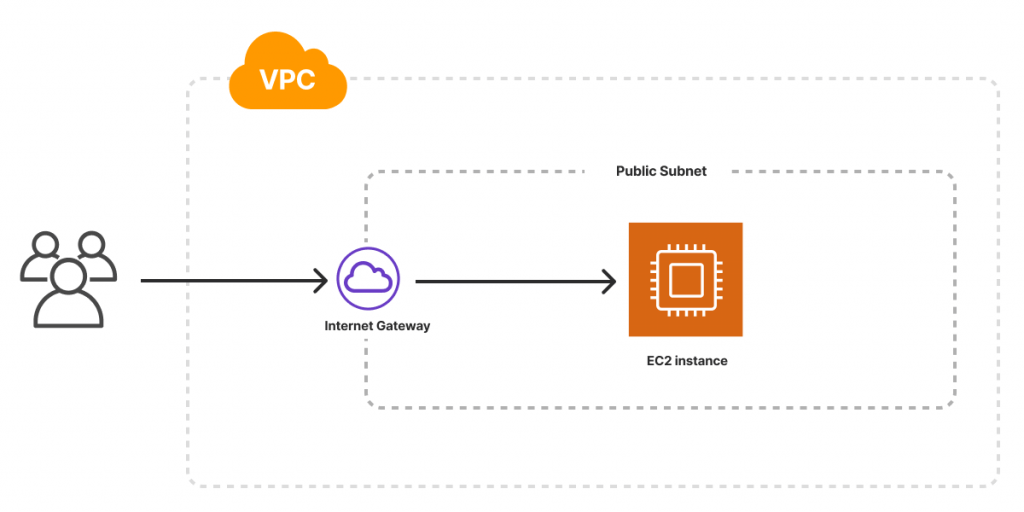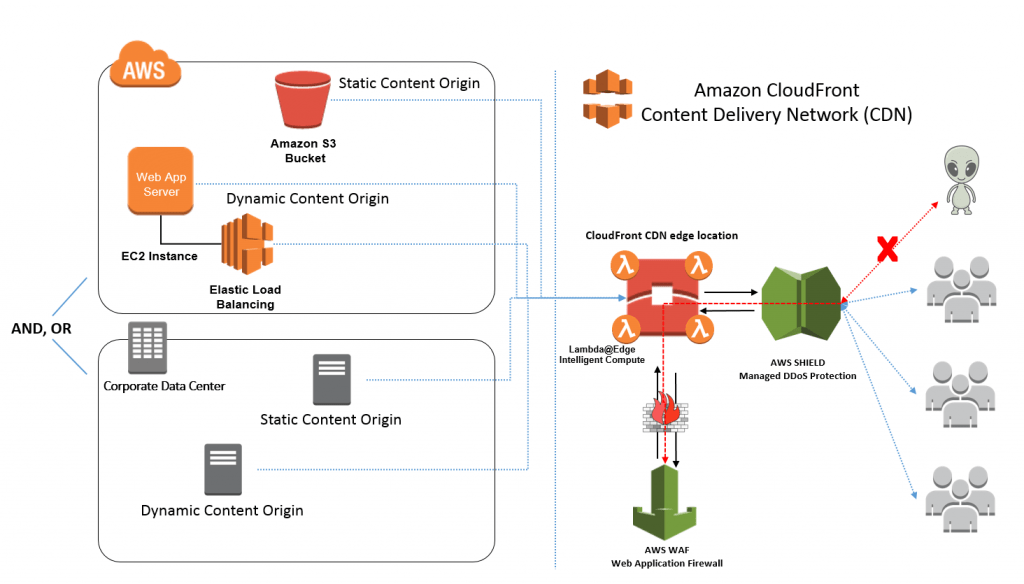
- Introduction to AWS and Cloud Computing
- Project 1: Deploy a Static Website Using Amazon S3
- Project 2: Set Up a Virtual Machine with EC2
- Project 3: Automate Server Deployment with AWS CloudFormation
- Project 4: Build a Serverless Application with AWS Lambda
- Project 5: Create a Simple Relational Database with Amazon RDS
- Project 6: Build a Scalable Web Application with Amazon Elastic Load Balancer (ELB)
- Project 7: Implement Cloud Storage with Amazon EFS
- Project 8: Set Up a Content Delivery Network (CDN) with Amazon CloudFront
- Project 9: Create a Cloud Monitoring Dashboard Using Amazon CloudWatch
- Project 10: Secure Your Application with AWS IAM Roles and Policies
- Conclusion
Introduction to AWS and Cloud Computing
Before diving into the projects, it’s essential to understand AWS and why it has become such a popular choice for developers and businesses alike. AWS (Amazon Web Services) is Amazon’s cloud computing platform, offering a wide range of cloud-based services, including computing power, storage, databases, machine learning, and more. It’s aimed at allowing businesses to scale their infrastructure quickly and efficiently without managing or investing in hardware. Cloud computing in AWS involves using a virtualized infrastructure that can be accessed via the Internet, and it has several benefits, such as flexibility, scalability, and affordability. Companies can only pay for the resources used, making AWS a very cost-effective solution. The power to dynamically scale infrastructure, respond to shifting workloads, and access a deep set of tools and services makes AWS a popular choice for developing and hosting applications in the cloud. Having given you an overview of AWS, let’s proceed to some fun and beginner-friendly AWS projects! These projects will provide you with some hands-on experience and assist you in developing your cloud-based applications with Amazon Web Services Training . Amazon Web Services (AWS) is the world’s leading cloud computing platform. Whether you want to develop scalable web applications, automate business workflows, or learn about cloud technology, AWS has a comprehensive set of services that support developers at any level. This blog post will explore 10 beginner-friendly AWS projects to start your journey. These projects will familiarize you with the core services of AWS and provide you with hands-on experience to implement your learning in real-life scenarios. Let’s get into the world of AWS and build!
Project 1: Deploy a Static Website Using Amazon S3
Objective: Learn how to host a static website (HTML, CSS, JS) on AWS.
Overview: Amazon S3 (Simple Storage Service) is a scalable storage service that’s one of the easiest ways to host a static website. This project will guide you through uploading your website files to an AWS amazon S3 bucket and configuring it for public access.
Steps:- Create an S3 bucket.
- Upload your static website files (HTML, CSS, JS).
- Configure the bucket for static website hosting.
- Set permissions to allow public access.
- Access your website using the provided URL.
Excited to Obtaining Your AWS Certificate? View The AWS Course Offered By ACTE Right Now!
Project 2: Set Up a Virtual Machine with EC2
The objective of this project is to launch a Virtual Machine (VM) in the cloud using AWS EC2 (Elastic Compute Cloud). AWS EC2 instance type is a scalable web service that provides computing capacity in the cloud, allowing users to run virtual machines with flexible configurations. In this project, you will learn how to create and manage EC2 instances on AWS. The process involves launching an EC2 instance via the AWS Management Console, selecting the appropriate instance type and operating system for your requirements, and configuring security groups to control network access. Once the instance is set up, you will connect to it via SSH for Linux or Remote Desktop Protocol (RDP) for Windows. Finally, you’ll install a web server like Apache or Nginx to host your website or application. This hands-on project provides a foundational understanding of virtual machines in the cloud, preparing you for more advanced setups and cloud infrastructure management.

Project 3: Automate Server Deployment with AWS CloudFormation
Objective: Automate the provisioning of AWS resources using CloudFormation.
Overview: AWS CloudFormation allows you to define your infrastructure as code (IaC). This means you can automatically set up AWS resources with a template file. In this project, you’ll create a basic stack with an EC2 instance and S3 bucket.
Steps:- Write a CloudFormation template in YAML or JSON.
- Use the AWS Management Console to deploy the stack.
- Verify the deployment and delete the stack.
Project 4: Build a Serverless Application with AWS Lambda
The objective of this project is to create a simple serverless application using AWS Lambda. Understanding AWS Lambda is key to leveraging serverless computing, where code runs without managing servers. It auto-scales, integrates with AWS services, and charges only for execution time, making it efficient and cost-effective. It’s ideal for building lightweight, event-driven applications. In this project, you will create a Lambda function that processes incoming data and stores it in an S3 bucket. The process involves creating a Lambda function, setting up an S3 bucket to store files, and configuring an event trigger (such as uploading a file to the S3 bucket). After setting everything up, you will test the Lambda function to ensure it processes and stores data correctly. With AWS Lambda, you can focus solely on writing code, without having to worry about managing the underlying infrastructure, making it a great entry point for working with serverless architectures. Additionally, AWS Lambda automatically scales depending on the number of events, ensuring efficient resource usage. The simplicity and scalability of Lambda make it an excellent choice for building microservices or handling event-driven workflows. By the end of this project, you’ll have a solid understanding of serverless computing and its capabilities.
Interested in Obtaining Your AWS Certificate? View The AWS Certification Training Offered By ACTE Right Now!
Project 5: Create a Simple Relational Database with Amazon RDS
Objective: Set up a relational database in the cloud using Amazon RDS.
Overview: Amazon RDS (Relational Database Service) is a managed database service that supports several database engines like MySQL, PostgreSQL, and SQL Server. In this project, you’ll create an RDS instance, connect it to your EC2 instance, and perform basic database operations.
Steps:- Create an RDS instance with a MySQL or PostgreSQL database.
- Set up security groups and permissions.
- Connect to the database using an EC2 instance.
- Create a simple table and insert data.
Project 6: Build a Scalable Web Application with Amazon Elastic Load Balancer (ELB)
The objective of this project is to learn how to distribute traffic across multiple EC2 instances using Elastic Load Balancer (ELB). ELB automatically distributes incoming application traffic across multiple EC2 instances, ensuring that your application can handle a larger volume of requests. In this project, you will launch multiple EC2 instances running a simple web application, then create and configure an ELB to distribute traffic evenly across these instances. After setting up the ELB, you will test the load balancing by accessing the application through the ELB DNS. This AWS Training project will teach you how to scale your web application and make it more fault-tolerant by ensuring high availability and efficient traffic distribution. Additionally, ELB helps maintain optimal performance even during traffic spikes, automatically adjusting capacity as needed. You will also gain practical knowledge in monitoring ELB’s performance and troubleshooting any issues that arise. By the end of this project, you’ll understand how to design scalable and resilient applications in the cloud.
Interested in Pursuing AWS Master’s Program?Enroll For AWS Master Course Today!
Project 7: Implement Cloud Storage with Amazon EFS
Objective: Set up Amazon Elastic File System (EFS) for shared storage.
Overview: Amazon EFS provides scalable file storage for EC2 instances. It’s a simple way to allow multiple instances to share a standard file system. In this project, you’ll mount an EFS file system on your EC2 instances and store files.
Steps:- Create an EFS file system.
- Mount the file system on an EC2 instance.
- Share files between multiple EC2 instances.
Project 8: Set Up a Content Delivery Network (CDN) with Amazon CloudFront
The objective of this project is to improve your website’s performance and delivery speed by using Amazon CloudFront, a Content Delivery Network (CDN). CloudFront caches copies of your content at edge locations around the world, allowing users to access the content from a server closest to them, which significantly reduces latency. In this project, you will create a CloudFront distribution linked to your S3 bucket or EC2 instance, configure caching and security settings, and test content delivery speed. By leveraging CloudFront, you can optimize your website’s performance, ensure faster loading times, and provide a better user experience for visitors worldwide. You will also gain insight into how caching rules and TTL (Time to Live) settings can be adjusted to further improve delivery efficiency. Additionally, you will learn how to integrate CloudFront with SSL certificates for secure content delivery. Finally, you’ll monitor CloudFront’s performance to ensure your website continues to perform optimally under varying traffic conditions. This project will also cover how to Integrate Azure CDN with web apps storage for enhanced content delivery options.

Project 9: Create a Cloud Monitoring Dashboard Using Amazon CloudWatch
Objective: Monitor your AWS resources using Amazon CloudWatch.
Overview: Amazon CloudWatch provides monitoring and observability for AWS resources. In this project, you will set up CloudWatch to monitor metrics like CPU utilization, memory usage, and disk I/O for your EC2 instances.
Steps:- Set up CloudWatch monitoring for an EC2 instance.
- Create custom CloudWatch Alarms for specific metrics.
- Visualize your metrics in a CloudWatch dashboard.
Preparing for AWS Job Interview? Check Out Our Blog on AWS Interview Questions & Answer
Project 10: Secure Your Application with AWS IAM Roles and Policies
The objective of this project is to learn how to control access to AWS resources using AWS Identity and Access Management (IAM). IAM allows you to define user permissions and control access to AWS services, ensuring that only authorized users can interact with specific resources. In this project, you will create IAM users and roles, define permissions using IAM policies, and assign these policies to resources such as S3 buckets or EC2 instances. Understanding and implementing IAM is crucial for maintaining a secure AWS environment and following best practices for access management, ensuring your resources are protected from unauthorized access. Additionally, you will learn how to set up multi-factor authentication (MFA) for enhanced security. You will also explore IAM best practices for the principle of least privilege, ensuring users only have the permissions necessary for their tasks. Finally, you will monitor and audit IAM activity using AWS Cloud trail track to change and ensure compliance.
Conclusion
AWS is an extensive and powerful platform offering a wide range of tools and services to help you build, deploy, and manage applications in the cloud. For beginners looking to get started, these 10 beginner-friendly projects provide an excellent entry point to dive into AWS services. By working through these projects, you’ll gain valuable, hands-on experience with key AWS tools like EC2, S3, Lambda, and more, building a strong foundation for tackling more advanced cloud computing tasks. Whether aiming to develop web applications, automate workflows, or deploy scalable infrastructure, AWS provides the resources and flexibility you need to get started. These projects will help you understand core concepts such as cloud storage, server less computing, database management, and networking within AWS. AWS Training will provide hands-on experience to reinforce these skills. Engaging with these beginner projects gives you the confidence to explore more sophisticated AWS services and solutions. Start building today and take the first step toward mastering cloud technologies. With AWS, you’ll unlock the potential to scale your projects, innovate faster, and harness the power of cloud computing to solve real-world problems.





